|
Auswahlmenü

Links
nils-uni@bluemer.name


|
|
Prof. Dr. Nils Blümer |

|
Achtung: viele Informationen auf diesen Seiten sind veraltet! Für aktuelle Informationen über Nils Blümer siehe Webseiten der KU.
Computing
Wesentliche Grundlagen für erfolgreiche Arbeiten in der Rechnergestützten Physik sind offensichtlich der Zugang zu ausreichenden Rechnerressourcen sowie die Beherrschung der Techniken (High-Performance Computing, IT-Management) zu deren effizientem Einsatz. Allgemein ist Informationsmanagement eine wichtige Aufgabe in der Führung von Arbeitsgruppen und Kollaborationen, insbesondere in der Wissenschaft (mit einer ständigen Fluktuation von Team-Mitgliedern) sowie in der Selbstorganisation. Im Folgenden diskutiere ich einige Aspekte, die für meine Gruppe besonders relevant sind oder von allgemeinem Interesse sein könnten.
Gruppen-HPC-Cluster
Meine Gruppe nutzt und betreibt einen eigenen (im Rechenzentrum untergebrachten) HPC-Linux-Cluster mit mehr als 200 CPU-Kernen, aktuell mit der folgenden Hardware:
- main file server: Supermicro 4U chassis with 24 SAS/SATA slots, 2x Intel Xeon Hapertown Quad Core E5430, 16 GB RAM, ARECA RAID SAS controller 20x ARC-1680ix with 20x 1 TB SAS hard disks (SEAGATE ST31000640SS), 2x 900 W redundant power supply, 2x 10 GbE (CX4), IPMI 2 interface
- 2 nodes, each with 2x Intel Xeon L5410, 16 GB, IPMI (in 1x Supermicro Twin 6015TC-T-10G)
- 16 nodes, each with 2x Intel Xeon Nehalem E5520, 8 GB, IPMI (in 4x Supermicro Twin2 6026TT-BTRF)
- 8 nodes, each with 2x Intel Xeon Westmere E5620, 8 GB, IPMI (in 2x Supermicro Twin2 6026TT-HTRF)
- main network: HP ProCurve Switch 2900-48G (J9050A): 48 GBit-ports, 2x 10 GbE Ports (CX4), 2 optical 10 GbE ports (X2)
- service network (IPMI): LevelOne Switch FastEthernet Switch 48Port+2PortGBE+1PortSFP (unmanaged)
- update installed in 11/2013: new 1U file server Supermicro 1018D-73MTF with 1x Intel Xeon E3-1240V3, 16 GB RAM, 8x SAS controller LSI 2308, 8x 960 GB Crucial M500 SSD, 2x 10 GbE (CX4), IPMI 2 interface
|
Setup:
|
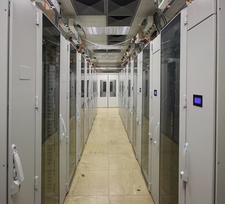 |


| |
Previous clusters (with P. van Dongen)
- 16 nodes with 2x AMD AthlonMP 1200, 2 GB, Tyan S2460 (year 2001-2006)
- 7 nodes with 2x AMD AthlonMP 2200, 1 GB, Tyan S2466 (year 2002-2006)
- 4 nodes with 2x AMD Opteron 244, 2 GB, Rioworks HDAMA (year 2003)
- 10 nodes with 2x AMD Opteron 246, 2 GB, Tyan S2882 (year 2004)
- 4 nodes with 2x AMD Opteron 270, 2 GB (year 2005)
- 8 nodes with 2x AMD Opteron 2216, 4 GB (year 2006)
- file servers (years 2001, 2005)
- Rembo boot server, PBS Pro / OpenPBS queueing system
|
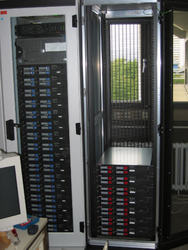
Group HPC cluster in 2003 |
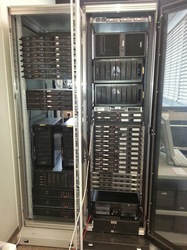
Group HPC cluster ~ 2008
|
Information management
- TWiki/FosWiki for collaboration, group calendar, documentation of ressources, programs, procedures, research data management, grading, etc.
- Subversion version control system for code development and collaborative writing of papers (while preserving all needed figures and corresponding data sets) and proposals
- rsnapshot for (local and remote) snapshots, e.g., of user data
- Unison file synchronizer (e.g. for two-way synchronization between laptops and NFS and between web servers)
- Sympa based mailing lists (with archives etc.)
- central department seminar web page (implemented using PHP+MySQL by Markus Himmerich, now administrated by Andreas Nussbaumer)
Usage of supercomputers and central HPC clusters
My experience with supercomputers and central HPC clusters dates back to 1995 and includes the following machines:
For better overview over jobs at different sites, I had created a portal for supercomputer batch queues.
Code development
Research codes and tools
Sample codes and templates
- Demonstration programs for constructing field lines and solving the poisson equation (year 2000; see also my more recent lecture on field theory).
- Program for generating generic and nonreversive random walks; computes probabilities for self-avoiding walks (SAWs): random_walk.c
- Simple Molecular dynamics code for Lennard-Jones fluid (template): MD_LJ_v05a.c, code: MD_LJ.c, both use pointer_utils.c; for explanations, see comp-sim_hw5.pdf
- Monte Carlo code for 2 D square Ising model with Metropolis single-spin flips oder Wolf cluster updates: mc_Ising_2D.c
- Statistische Auswertung einer Zeitreihe (unter Berücksichtigung der Autokorrelation; Steuerung über Kommandozeile: -h für Hilfe): stats_template.c (highlighted html), stats_template.c, stats_v1_4.c (highlighted html), stats_v1_4.c; Windows package (mit cygwin1.dll): stats_windows.zip.
- Einfacher Zufallszahlengenerator: random_nums_v4.c (highlighted html), random_nums_v4.c
- MC-Simulation für das 2D Ising-Modell (Templat): mc_Ising_2D_template2a.c (highlighted html), mc_Ising_2D_template2a.c
- Code für polynomiale Least-squares-fits: polyfit7.c (vorerst nur zur Illustration, verweist auf nicht-freie Module, also nicht kompilierbar!)
- Simple Molecular dynamics code for Lennard-Jones fluid (template): MD_LJ_v05a.c uses pointer_utils.c
See also course pages on computer simulations and numerical methods listed on my lectures page.
Parallelization, tuning, porting, and benchmarking
(to be continued, sample benchmark results shown below)
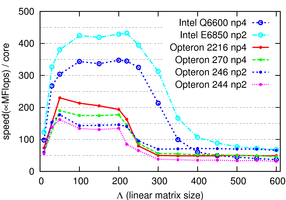
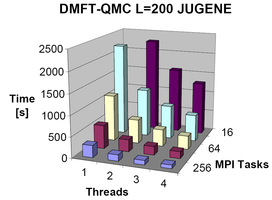
Miscellaneous
- Arbeitsprobe Linux (Aufgabenstellung zur Auswahl eines Linux-Administrators für das Institut für Physik im Mai 2009)
|





